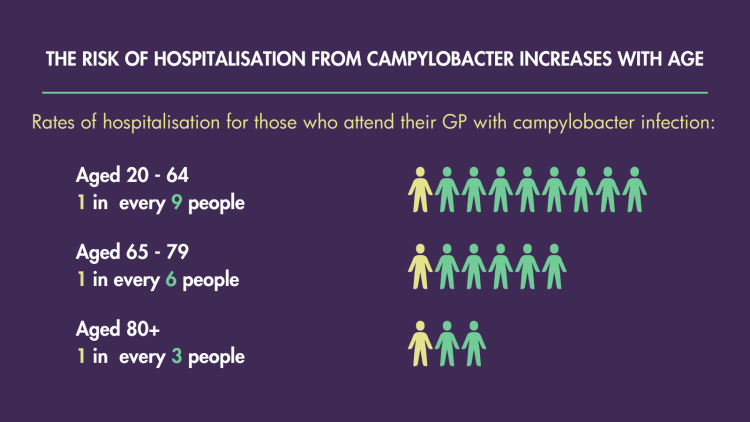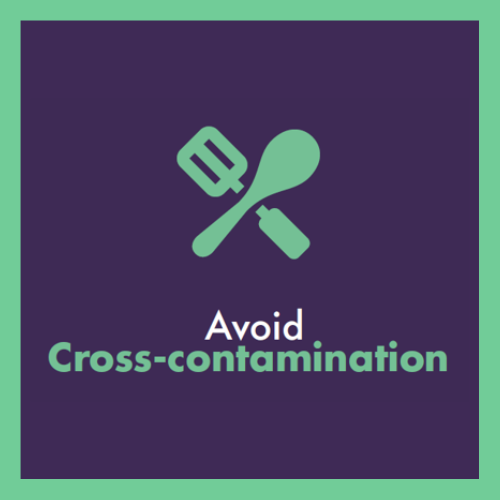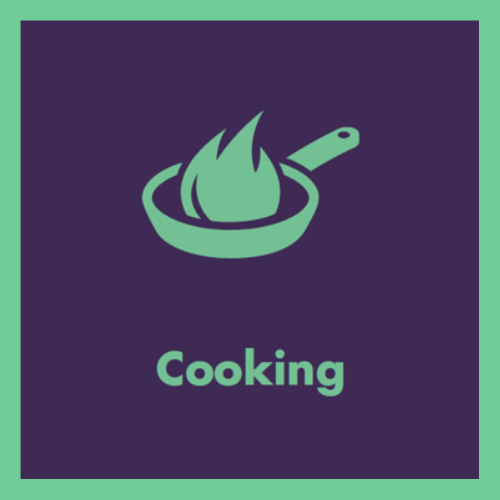What's on this page:
Campylobacter is the most common bacterial cause of food poisoning in Scotland and the rest of the UK. It causes a diarrhoeal infection and, although there are more cases in the warmer months, people can get it at any time of the year.
People can get campylobacter infection from environmental exposures (for example, contact with farm animals) or by eating contaminated food. It is most commonly spread by improper handling, preparation and cooking of raw chicken.
Fact
There are an estimated 54,000 cases of campylobacteriosis in Scotland every year
Campylobacter in over 65s
People aged 65 and over are at greater risk of serious side effects from campylobacter poisoning.
The body’s immune system weakens as you age. This increases the risk of becoming ill from food poisoning. Illness for people in this group is often more severe and may lead to serious illness, hospitalisation or even death.

Therefore, it is important to be aware of how to prepare food safely if you're in this group or if you're making food for anyone aged over 65.
Symptoms of campylobacter poisoning
Most people recover fully from campylobacter poisoning and treatment is not usually required. Anyone can get ill from it, but people aged over 65 and young children are at a greater risk of infection.
The time taken from ingestion of campylobacter to the onset of symptoms is usually 2 to 5 days but it can be as short as 1 day or as long as 11 days. Symptoms typically last 7 days.
Typical illness is characterised by:
- diarrhoea (sometimes bloody)
- abdominal pain
- high temperature
- occasionally nausea and vomiting
In some people, campylobacter can result in much more serious illness post infection. This includes:
- irritable bowel syndrome (IBS)
- reactive arthritis
- in rare cases, Guillain-Barré syndrome – a serious condition of the nervous system
How is campylobacter spread?
People can become ill with campylobacter by eating contaminated food, drinking contaminated water, or having contact with infected animals (such as pets and farm animals). In the kitchen, campylobacter can spread by improper handling and cooking of food, or eating something that touched it (i.e. cross-contamination).
Foods commonly associated with the transmission of campylobacter and cases of food poisoning include:
- raw chicken and other poultry (most common source)
- offal, such as liver
- unpasteurised dairy products
- untreated water
Over half of cases of campylobacter food poisoning come from contaminated poultry meat. Even one drop of juice from raw poultry can have enough campylobacter in it to infect a person.
So it's especially important to cook chicken meat thoroughly, whether it’s in a dish or cooking it on the barbecue. To avoid pink chicken on the barbecue follow our barbecue food safety advice.
Top tip
Never wash raw chicken. It can spread campylobacter around the kitchen sink and surfaces.
Preventing campylobacter poisoning
For other food safety advice to keep yourself and family safe consider the '4Cs': chill, clean, avoid cross-contamination and cook.
 Chilling
Chilling
Defrost chicken in the fridge in a covered container on the bottom shelf away from cooked foods. Some bacteria, such as campylobacter, love to grow at temperatures above 8°C so it’s important to keep chicken cold when defrosting. Always check chicken is fully defrosted before cooking.
 Cleaning
Cleaning
Always wash your hands in warm, soapy water after handling raw chicken. Effective cleaning removes bacteria on hands, equipment and surfaces, helping to stop campylobacter from spreading onto food.
 Avoid cross-contamination
Avoid cross-contamination
Never wash raw chicken! This can splash harmful bacteria around your kitchen sink and surfaces. Use different chopping boards and utensils for raw chicken and ready-to-eat food. If you can’t use different chopping boards and utensils, thoroughly wash them in hot, soapy water between use.
 Cooking
Cooking
Check the meat is cooked to 75°C in the thickest part using a meat thermometer. Make sure there’s no pink meat, the juices run clear and it’s steaming hot in the middle. This is the only way to make sure that harmful bacteria are killed.
Fact
Chicken is the largest source of human infection, causing 52-68% of campylobacteriosis cases
Have a look at our simple, easy and healthy chicken curry recipe card for an example of how to safely prepare chicken in line with our guidance.
Campylobacter campaign partner toolkit
Support our campylobacter prevention campaign
Causes of foodborne illness
One of our key priorities is to protect consumers in Scotland from the risks of foodborne illness.
At home
Whether you’re shopping or cooking, these tips will help make sure the food you cook and eat won’t do you any harm.